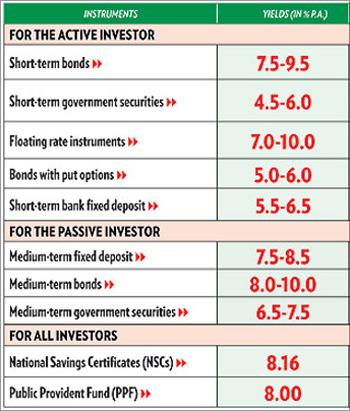
While investors made a decent return through bond price gains since the beginning of last year, the next could be a rollercoaster ride.
Governments across the world were decreasing interest rates to kick start their domestic economies. That led to a global flush in liquidity, mostly low inflation and a surge in bond prices last year. But, now, as emerging economies like India grapple with this surplus liquidity, inflation is threatening to spiral upwards.
Already primary food prices are on the upswing, as it increased from being negative to close to 20 per cent. As the government tries to cool down inflation, the Reserve Bank of India could raise rates in 2010. For investors, it may be a time to play a more active role in managing fixed income portfolios.
Fixed income investments help in both capital preservation and income generation but there is a common misconception that bond markets are safe havens.
Like stock markets, bond markets also face volatility and bond prices fluctuate. Volatility is high especially when interest rates change. The inverse relationship between bond prices and inflation rates forms the core of the bond market, similar to the inverse relationship between yields and bond prices.
When interest rates go up, bond prices fall and when bond prices fall, yields move up. By all accounts, 2009 was an eventful year for the markets. The sliding interest rates and mostly low inflation saw investors gaining on bond prices.
In other words, it was a field year for fixed income investors. But 2010 may witness rising interest rates, zooming inflation, rising yields and falling bond prices.
That means, as interest rates rise, new securities offering higher interest will become available and investors will be willing to pay less for existing securities that offer lower interest. . . .

Step 1: Weigh your priorities
The most important step in managing a fixed income portfolio is to determine what kind of investor you are. Are you an active investor or a passive investor?
An active investor is one who regularly monitors his portfolio to mitigate risks using several strategies and profits from trading in the secondary market. A passive investor has just one strategy -- buy and hold, and hence his risks are minimal.
If you are a passive investor who is going to hold on to his investment till maturity, other things being equal, your interest rate risk is almost nil. This is because you will be getting the interest and the principal promised during issue.
You can start at step 4. But you can, of course, follow steps 1-3 if you want to turn into an active investor.
If you are an active investor read on to know how to manage your investments and protect your portfolio from rise in interest rates and inflation. . . .

Step 2: Assess your fixed income portfolio duration
All bond investors know about maturity but very few are aware of duration. Bond maturity is pretty simple. It gives you the number of years until the bond matures. But this is not a great measure of the 'length' of a bond as it does not take into account interest payments.
This means you do not know how sensitive the bond is to interest rate changes. Duration helps to determine interest rate sensitivity of a bond by calculating the time weighted average of all cash flows (interest and principal) that accrue to the bond.
In simple terms, it uses all payments that you will receive (from the bond) in future to determine how long it will take to get back its true cost. Like maturity, duration is measured in years.
For example, Shriram Transport Finance Company's bond with a coupon rate of 11.5 per cent and a yield of 9.92 per cent has a maturity of 4.83 years. Assuming a semi annual interest payment, its duration would be 3.61 years.
For instance, generally 5-year duration means that the bond's value is likely to fall by 5 per cent if there is a 1 per cent rise in interest rates, and would increase by 5 per cent if interest rates fall by 1 per cent.
Let us take the example of LIC Housing Finance AAA rated bond, which pays a coupon rate of 6.9 per cent. As of 16 December 2009, the price of this bond was Rs 100.38. Duration of this bond is 1.23 years. . . .

If Interest rate rises by 1 per cent, the bond value would fall by 1.23 per cent to reach the price of Rs 99.15. The most popular, formula to calculate duration is the Macaulay duration, which is a bit complex for lay investors.
You can get this figure from your broker or financial advisor. Duration decreases as the bond moves closer to maturity and eventually converges with a bond's maturity.
For a zero coupon bond, duration is equal to maturity. The longer the duration, the greater the sensitivity to interest rate changes.
Step 3: Assess other factors that affect bond prices
Interest paid and term to maturity (TTM) are also important factors to consider. If TTM and price of a bond remain constant, the higher the interest paid, the lower will be the volatility.
If the interest paid and price is constant, the bond with the longer TTM will display higher volatility. So given these facts, to protect bonds from interest rate changes, it seems prudent to invest in a security with high interest payments or coupon rate and a short TTM. . . .

Step 4: Look at suitable choices
Since interest rates are expected to rise, it is best not to lock in your money at prevailing rates for long. So short-term instruments are your best bet.
Always choose securities based on your risk profile. For the risk-lover, short-term bonds, floating rate instruments and bonds with put options are good choices. The risk averse can look at medium term fixed deposits and bonds.
Fixed deposits are preferable investment options as they offer better safety when compared to bonds. Since interest rates are likely to go up, you may get better rates for your fixed deposit in the future.
Public Provident Fund (PPF) and National Savings Certificate (NSC) are always in vogue. PPF gives a very attractive tax free return of 8 per cent, which means the effective return is about 12.8 per cent for investors in the highest tax bracket.
In the case of NSC, interest is taxable but are eligible for deduction under Section 80C of the Income Tax Act. NSC requires just a one-time investment while PPF involves regular investments. Another notable point is that these instruments offer an additional benefit -- tax savings. Payments towards these instruments are eligible for tax benefits under Section 80C.
The only disadvantage with these instruments is that their interest rates do not change with the interest rates prevailing in the country as they are government determined.
Default risks involved in these investments are minimum. . . .

Step 5: Keep your portfolio 'flexible'
In a rising interest rate scenario, 'flexibility' is the operative word. Keep your portfolio flexible. This is where laddering helps.
Laddering is a strategy where you build a ladder by investing equal amount of money in fixed income instruments that mature at regular time intervals, simultaneously. For instance, 1-, 2- and 3-year fixed deposits.
The main advantage with this strategy is that you do not get stuck with interest rates. As soon as the instruments mature, you can invest them in instruments that offer better interest. Also, you can manage bull and bear runs in the bond market better.
This strategy also helps you diversify your investments and reduces reinvestment risks. The best part is that it ensures that you get a steady stream of cash flows at regular intervals. You can create a bond ladder by investing in different fixed income instruments too. It is best to start with shorter duration securities and then expand your ladder as you move along.
You can also keep your portfolio flexible by looking for instruments that offer the highest rate for the shortest possible term so that you are not stuck when interest rates start to climb. You should start moving your investments to higher rates along with rising interest rates.
Remember to 'move up along with the interest rates'. . . .

Threats
Rising interest rates: Rates are expected to harden if the Reserve Bank of India squeezes money supply in the economy.
Rising inflation: This is one big dampener for fixed income investors as it eats into the returns and lowers the real return of the investment.
Volatile bond markets: As interest rates are likely to firm up, the volatility in the bond markets could increase. Speculators tend to chase yields in the short run, which increases price fluctuation in bond markets.
Action
Ladder your portfolio: Bond laddering is buying bonds with different maturities and holding them till they maturity. Ensure that a portion of your portfolio matures each year and that you invest equal amount across maturities to make the best of this strategy
Scout for yields: Invest proceeds from maturing bonds in newly issued bonds that have a higher coupon rates. Look for high-yielding investments, though not at the cost of lower credit ratings, as banks begin to offer them.
Go for short-term paper: If you like to trade debt on secondary market then choose securities with the shortest duration and higher rates. For passive investors, it is best to hold bonds till the security matures.